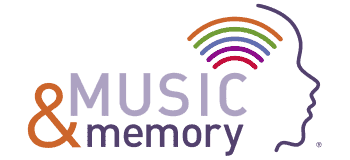
Hospice care takes many forms—medical care, pain management, support therapies, compassionate attention to emotional and spiritual needs—in a variety of settings, from home to residential hospices, from nursing homes to hospitals. But there is one quality that all hospices share: a commitment to ensuring quality of life for the patient and support for his or her loved ones, as well.
Beloved music can play a significant role in that mix. That’s the experience of Barnabas Health Hospice in West Orange, New Jersey, which has been offering Music & Memory’s personalized music program for the past three-and-a-half years.
One of the first hospices to become a MUSIC & MEMORY® Certified Care Organization, with original grant funding from the Healthcare Foundation of New Jersey, Barnabas Health Hospice now extends its personalized music program to include two satellite offices in the southern part of the state. About 300 people, both in home hospice and in nursing home settings, have been able to enjoy their favorite music, easing their end-of-life journeys.
“He Died with His Headphones On”
Mary Murray, a registered nurse and former clinical educator for Barnabas Health Hospice, was instrumental in setting up and running the program until this past December. She recalls one of the first patients to experience Music & Memory, a man living in a nursing home whose dementia was beginning to limit his ability to communicate.
“He had a very loving wife who visited daily, but he was quite withdrawn,” recalls Murray. “His wife felt he wasn’t able to feel any happiness. We introduced the program to her and asked what kind of music he liked. It turns out he loved Italian opera, but she hated it and had thrown out all of his CDs. So I went back to iTunes and did some research, found Italian opera’s top hits. We loaded them onto an iPod and put the headphones on him.”
The reaction wasn’t what she expected. “Tears started running down his face,” says Murray. “We thought we’d done something terrible! But his wife said, no, that was always his reaction. He was really moved. Listening to the music became something they could do together. She felt that she was able to give him some joy. He died with his headphones on.”
Tapping Happy Memories that Balance Loss
That experience is but one of many stories gathered over the years by Barnabas Health Hospice staff. The positive benefits for patients have been matched by the boost that Music & Memory has given to families, as well.
“One thing we really didn’t expect was the effect it had on families,” says Murray. “We asked them to tell us what music is important to your mom, what did she listen to when cooking dinner, or what was your parents’ wedding song or favorite church music. It brought the family back to a time when their loved one’s life wasn’t all about hospice and dying—really happy family memories.”
Pioneering the program in a hospice setting brought challenges, especially since Barnabas Health Hospice serves patients both at home and in nursing homes. A volunteer coordinator was hired to manage the program, with hospice volunteers creating playlists and delivering the iPods to patients.
A Key Role for Hospice Volunteers
“We have about 150 iPods out at the moment,” says Volunteer Coordinator Leigh Conforti, who manages more than 140 volunteers. Requests for the iPods can come from a variety of sources—social workers, nurse managers or the volunteers themselves. Typically, the volunteers do the detective work of learning about the individual’s favorite music and create the playlists. They also deliver the equipment—an iPod, headphones, playlist and instructions—in a special bag sewn by another volunteer, and help the patient and family learn how to use the music.
Not only is the program enthusiastically embraced by Barnabas Health Hospice volunteers; Conforti says it also is “the perfect way for volunteers to get in patient hours.” Medicare requires that five percent of hospice volunteer time be dedicated to working directly with patients.
Murray says that Barnabas Health Hospice made a conscious decision to expand the program to all hospice patients, not just those diagnosed with dementia. They provide a stamped return envelope with the iPod, so that it can be re-used when no longer needed. In addition, upon a patient’s death, the Volunteer Coordinator will make a condolence call and sensitively worded request to return the equipment so that it can be refreshed for another patient.
Relieving Pain in the Broadest Sense
“We made the program open to any patients, regardless of where they live,” says Murray. “We left the equipment at bedside. We lost a few iPods along the way, but not many. It was more important to make the iPod accessible and likely to be used.”
In 2016, Barnabas Health Hospice became part of a joint venture, through a partnership with the VNA Health Group, Inc. and RWJ Barnabas Health, that employs music therapists for the benefit of patients. Murray notes that the Music & Memory personalized music program provides another way for the joint venture to share the pleasures of music with more hospice patients and families.
“Personalized music has relieved people’s pain, helped them to feel better and more comfortable,” she says. “In the hospice realm, when we think of pain, we think of it in broad terms. A person may have physical pain from a wound, or pain from cardiac angina, but there’s always more. There’s spiritual pain—questions like why is God doing this to me—or the personal pain of feeling you’ve lost everything. There is much sadness in this work. Music & Memory is a service that is uplifting and happy and joyful for everyone involved.”
Founded in 2010, MUSIC & MEMORY® is a non-profit organization that brings personalized music into the lives of people with cognitive or physical conditions through digital music technology, vastly improving quality of life.
Image Credit: Frank McKenna
